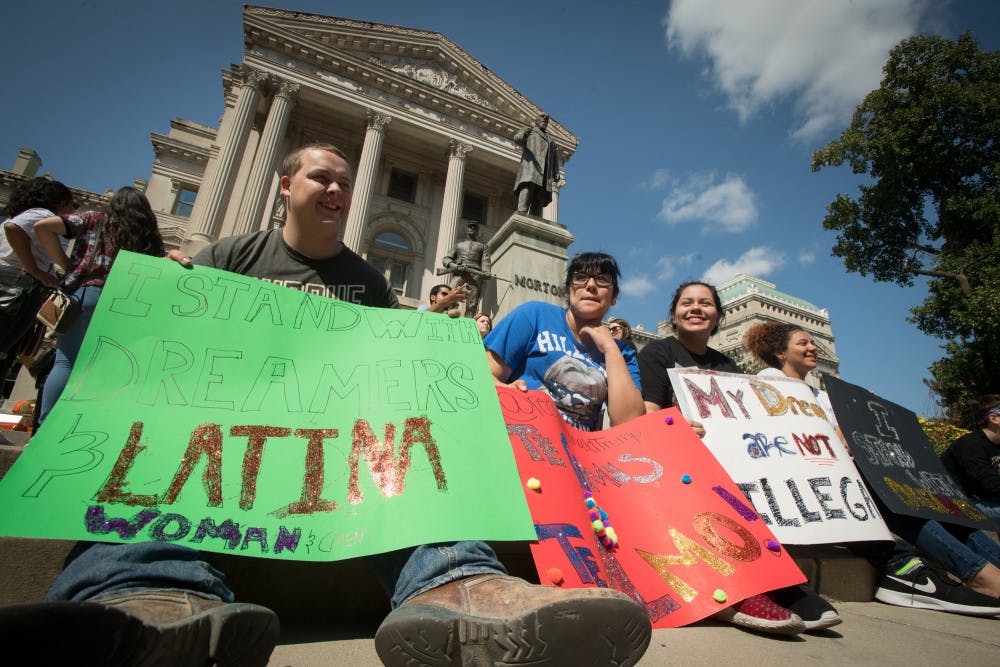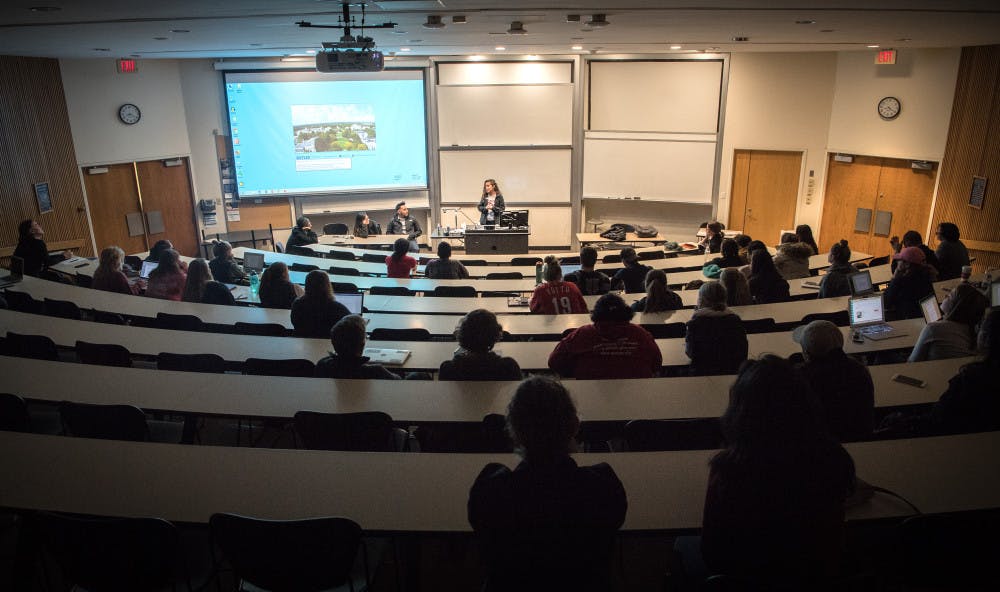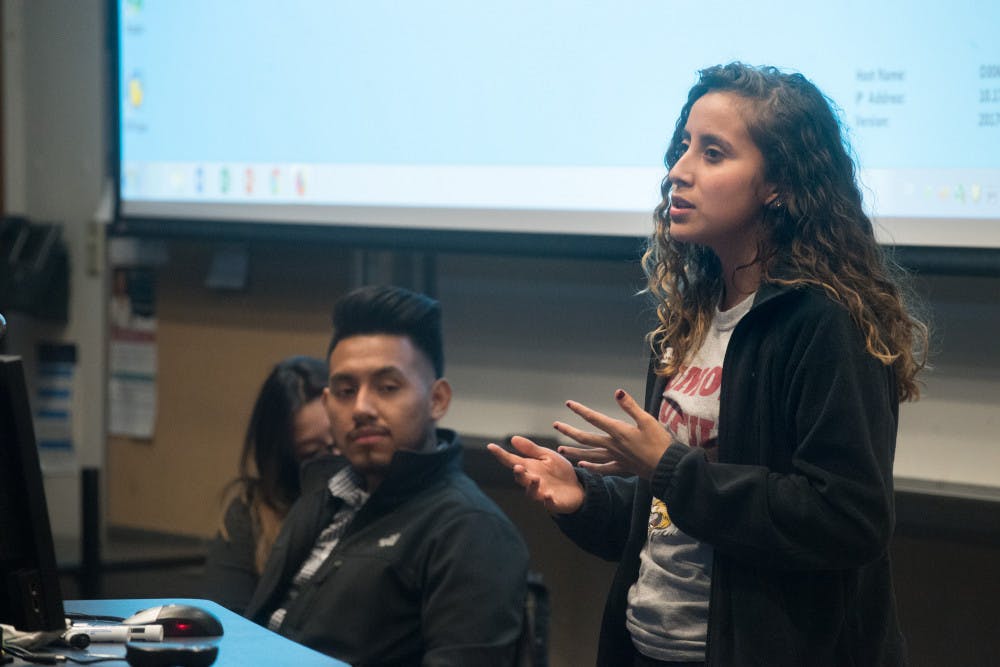by Ron Hanson
Flight or Fight
Saturday mornings in Indianapolis can still be the lazy kind of mornings that earned the city its “Naptown” nickname.
September 9, 2017 was sizing up to be one of those Saturdays.
The 20-somethings of Indy’s urban residential boom were hitting their morning jogging routes up, down and around downtown. New York – Meridian – Market – Capitol and back, and beyond. Young professionals had traded their business suits for sweats and hoodies as they tried to beat the light change while balancing frappes, cell phones and the day ahead. Indy’s newfound wealth was in full leisurely force as a rising group of teens and adults funneled toward the Statehouse.
One cluster of high schoolers carries handmade signs, their brown skin glistened beneath a pristine blue sky, jet black manes bounced up and down in sync with every brisk step they took. Animated conversations could be heard as they approached.
Some spoke in Spanish.
Most chose to be heard in English.
All were assembling for a common cause.
Four days earlier the Department of Justice declared an end to the Deferred Action for Childhood Arrivals program, at the guidance of President Trump.
DACA’s sudden demise meant that an estimated 800,000 undocumented immigrants who came to the U.S. as children would no longer receive DACA protections, if new legislation is not passed by March.
Their situation is the same situation that affects nearly 160 IUPUI students who have declared DACA status.
People continued to gather at the base of the Statehouse steps. They chatted, mingled and waited as a college aged Latina made her way up the steps – la bandera Mexicana – flowing from her shoulders.
Her steps fell with urgency.
Her body language determined.
Then she stopped – she turned – she waited.
She waited to share her story.
She wanted to never return to the shadows.
The moment had come for Sandy Rivera, the IUPUI education major, born in Matamoros Mexico, raised in Indianapolis, Indiana, to take a stand. It was time to fight for her future and the future of immigrant children like her, who came to the United States “without inspection” and remain in the only country she has ever known.

Protesters gather at Indiana Statehouse, Sept. 9, 2017, after President Trump ended DACA protections on Sept 9. Photo by Ron Hanson
Living the Dream
“Sandy Rivera is feeling nervous,” so said the emoji on Rivera’s Facebook page, Aug. 24.
Rivera had enrolled in 15 credit hours, was serving as secretary for the Latino Student Association, teaching children Spanish, working as an intern at the Indiana Latino Institute and working part time at a thrift store. All while helping create and propose a bill to help undocumented people in Indy.
Sandy had damn good reason to feel nervous.
She also had great reason to be proud.
“What is admirable about Sandy is the passion she has for documented and undocumented students.” Karina Garduno, Asst. Dir. of Multicultural Programming said.
Despite being a country that sells itself as a “melting pot,” color still matters in the United States. Color, or the lack thereof, means status. The fairer the skin, the greater the privilege.
Rivera doesn’t fit the stereotypical Hispanic visual. Her light brown skin is complemented by long wavy light brown hair. She attributes these traits as reason for escaping judgement and questions about her status.
“Growing up it (undocumented) wasn’t really a factor,” Rivera recalls. “I went to school like everybody else. I really didn’t notice a difference. I never really encountered racism.”
If you were to bump into Sandy on campus, you would be hard pressed to see her ethnicity. Her English is better than her Spanish and her cheerful disposition offers no clue to the turmoil that surrounds her life. As far as anyone is concerned, Sandy Rivera is living the dream.
If she is, it comes with no help from the government.
When Sandy began considering college, the reality of her immigrant status suddenly got real.
Despite both parents and herself, working and paying into the U.S. tax system, Sandy is unable to receive any federal or state aid.
When it was time for Rivera’s middle school classmates to apply for 21st century scholarship aid, all she could do was sit and wait while they filled out the form. When it was time to complete the Free Application for Federal Student Aid, all she could do all she could do was apply and see how much FASFA relief she would miss out.
If college was her dream, she needed to make her own bank because Sandy Rivera, born in Matamoros, Mexico, raised in Indianapolis, Indiana, had no birthright.
She was without papers.

Sandy Rivera, junior, speaks at the Indiana Statehouse during protest against the ending of DACA, Sept. 9, 2017. Photo by Ron Hanson
An Uneventful Arrival
Matamoros borders Brownsville at the far southernmost tip of Texas. The only things that separate the two towns are a fence, the Rio Grande and an $18 trillion economy. If there was no fence, Matamoros would be the “other side of the tracks” to the Rio Grande.
Sandy’s arrival in the U.S. came rather unceremoniously in December 2002. Over a year had passed since 9/11 and immigration tensions had risen to a point where crossing the border was becoming too dangerous.
After walking a couple miles with her mother and brother through the outskirts of Matamoros, they boarded a city bus that took them to the border where they boarded a Greyhound and headed north into the land of opportunity.
Seven hours later 4-year old Sandy Rivera would spend her first night in the United States at an aunt’s house in Houston.
After spending time in Houston and Pensacola, Florida, they were reunited with her father in Indianapolis where he had found a means to provide by installing drywall in the new homes of the rapidly expanding housing bubble.
It would be Indianapolis, Naptown, where young Sandy, a girl with no memories of her birthplace, would grow up, learning about the great melting pot, being sold American dream, and being taught to believe that life, liberty and the pursuit of happiness was real.
Her Indiana home would also be the place where she would learn the civics lessons that would soon become relevant to her future.
Pitching the DREAM
Washington D.C. is exciting, mystifying and intimidating all in the same instant. Even to the most seasoned activist, D.C. is known as a place that doesn’t ask twice for you to speak up and be heard.
If you have something to say, you better be prepared to say it. Your 15 minutes of fame will more than likely be two. Two minutes to make your pitch, to the power brokers of the most powerful democracy created, about why you deserve to be heard.
This was the case in October when Rivera flew to Washington with other young immigrants from around the country make their case for new action on the Development Relief and Education for Alien Minors Act.
“We gave our two-minute elevator speech about our story and how we contributed to society, how we helped improve the economy, how DACA has affected us and how the DREAM Act will help us,” Rivera said.
It was a hard sell going into meetings with some of the staunchest opponents on immigration, but Rivera remained undiscouraged after emerging from the busiest bazaar of political lobbying on earth.
“I feel like even though they put on a face that we didn’t get over to them, I feel like in way we did,” Rivera concluded.
Sandy Rivera, the happy warrior, the dreamer, street fighter for all immigrants.

Rivera speaks with Indiana Undocumented Youth Alliance members at Butler University panel discussion, Nov. 30, 2017.
DACA vs DREAM Act
Rivera’s political fight to finish college and pursue a career in U.S. as a grade school teacher hinges on two pieces of legislation, DACA and the DREAM Act.
DACA provides the ability, for any immigrant child who qualifies, to remain in the U.S. without fear of deportation. DACA allows them to plan their lives, get an education and work in the U.S. legally. Before DACA’s demise, participants were required to renew every two years.
This protection is critical for someone, like Sandy, who is paying her own way through college. Until this year Rivera was paying for college by working two to three jobs. This year she has managed to earn $3000 in private scholarship aid that will help pay for her plus $10,000 per year in-state tuition.
One misconception about DACA is that it is only for Hispanics.
“The face of DACA has typically been young Latinos, but there are students from every continent who are DACA students, particularly here at IUPUI,” Garduno explained.
The DREAM Act provides a path toward legal status and possible citizenship for young immigrants. It would become the key legislation that gives, those who qualify, the opportunity to realize the grade school promises made by their teachers in “a nation of immigrants.”
Current Political Climate Change
It’s late as Rivera fights back a case of the yawns.
But her gasps for air are not because she is buried in a mountain of books, notes and coffee with final exams looming.
It is the last day of November and for Rivera, who was unable to renew her DACA card, the clock is ticking.
She participates in a panel discussion for the Indiana Undocumented Youth Alliance at Butler University with fellow immigrants who arrived in the U.S. “without inspection.”
Rivera stands at the podium and tells her story to the mostly white audience as they tap away on their laptops. They Listen and study, they listen and study some more. Their $160,000 undergraduate education paid through full rides, scholarships, student loans, and the intergenerational wealth of their U.S. birthright.

Rivera plans to teach elementary education and advocate for other undocumented immigrants in the U.S. Photo by Ron Hanson
“A lot of people are giving up,” Patricia Alonso, co-founder of the Undocumented Youth Alliance said. “We see very few individuals like Sandy who actually want to continue the fight, even though it’s going to be hard.”
“She is always looking for ways to bring about awareness to individuals who may not be aware and she continues to fight for those students who are here,” Garduno adds.
If, life continues as planned, Rivera will begin student teaching next year.
If, Congress acts and passes a DACA II by March, she will graduate in the fall, 2019.
If, she wins her fight, Rivera will engage in an elementary education career, with the hopes of one day creating her own educational non-profit that provides resources to under sourced communities.
If, the current political climate shifts back to a kinder gentler United States, through the DREAM Act, Sandy Rivera of Matamoros, Mexico, raised and educated in Indianapolis, Indiana may one day become Sandy Rivera, citizen of the United States of America.
If.





